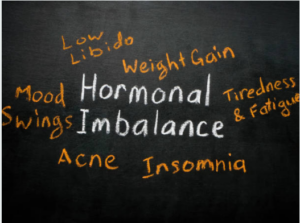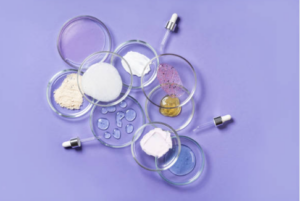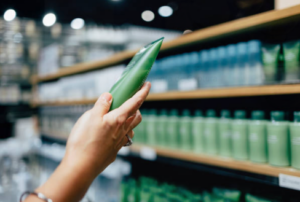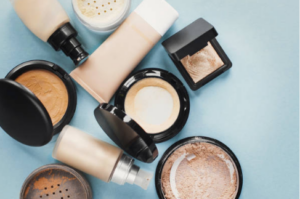Examining Hormone-Altering Chemicals

In the world of beauty and personal care, we often prioritize the pursuit of radiant skin, luscious hair, and overall wellness. Yet, as we delve into the intricate world of beauty products, it’s crucial to understand the potential impact that certain chemicals can have on our bodies beyond their aesthetic benefits. Endocrine disruptors, a class of chemicals found in some beauty products, have garnered attention for their potential to interfere with hormonal systems, leading to a range of health concerns. In this in-depth exploration, we’ll delve into the world of endocrine disruptors, their presence in beauty products, and how to make informed choices to protect both your beauty and health.
Picture an orchestra with multiple instruments, each contributing its unique sound to create a harmonious melody. Similarly, the endocrine system comprises a network of glands, each responsible for producing specific hormones that exert control over different bodily functions. These glands include the pituitary gland, thyroid gland, adrenal glands, pancreas, ovaries, and testes. The hormones they produce travel through the bloodstream, acting as messengers that communicate with target cells and organs.
Like a well-choreographed dance, the endocrine system operates through a series of intricate feedback loops. These loops involve a delicate interplay between hormone production, release, and regulation. When a certain hormone level in the body rises or falls, feedback mechanisms prompt glands to adjust their hormone production to maintain equilibrium. This balance is crucial for optimal health and ensures that bodily functions operate within their desired ranges.
Understanding the endocrine system requires familiarizing oneself with some of its key players—hormones—and the roles they play in maintaining bodily harmony:
- Estrogen and Testosterone: These sex hormones are vital for reproductive development and function. Estrogen supports the growth and maintenance of female reproductive organs, while testosterone does the same for male reproductive organs.
- Insulin: Produced by the pancreas, insulin regulates glucose levels in the bloodstream. It allows cells to absorb glucose for energy or storage and maintains stable blood sugar levels.
- Thyroid Hormones: Thyroid hormones, like thyroxine (T4) and triiodothyronine (T3), influence metabolism, energy production, and overall growth and development.
- Cortisol: Secreted by the adrenal glands, cortisol is often referred to as the “stress hormone.” It plays a critical role in managing stress responses, regulating metabolism, and maintaining immune function.
- Growth Hormone: Produced by the pituitary gland, growth hormone is essential for growth during childhood and adolescence, as well as for maintaining healthy body composition and bone density.
Endocrine disruptors are synthetic or naturally occurring chemicals that can interfere with the body’s endocrine system, often mimicking, blocking, or altering the action of natural hormones. These chemicals can lead to imbalances in the endocrine system, potentially causing a range of health issues, including reproductive problems, developmental disorders, and even cancer.
The beauty industry boasts a plethora of products promising youthful skin, voluminous hair, and an overall sense of well-being. However, it’s essential to be aware that not all products are created equal, and some may contain endocrine-disrupting chemicals that can be absorbed through the skin and impact the body’s hormonal balance.
Common Endocrine Disruptors in Beauty Products
1. Phthalates: A Hidden Intruder
Origins: Phthalates are often used as plasticizers to enhance the flexibility and durability of plastics. However, they’ve also found their way into beauty products, primarily fragrances, nail polishes, and hair sprays. These chemicals are used to help products adhere and hold their scents longer.
Implications: Phthalates have raised significant concern due to their potential impact on reproductive health. They are known to disrupt hormone signaling, particularly interfering with testosterone and estrogen production. Exposure to phthalates has been linked to developmental abnormalities in the reproductive system, as well as disruptions in thyroid function.
2. Parabens: Preservatives with Potential Risks
Origins: Parabens are a group of synthetic chemicals used as preservatives in cosmetics and personal care products. Their purpose is to prevent the growth of bacteria and mold, prolonging the shelf life of these products.
Implications: Parabens have gained attention due to their estrogen-mimicking properties. When absorbed through the skin, they can potentially disrupt the endocrine system by binding to estrogen receptors. This has raised concerns about their role in hormone-related cancers, particularly breast cancer. While research is ongoing, many consumers are opting for paraben-free products to reduce their potential risk.
3. BPA (Bisphenol A): A Tale of Plastic and Beyond
Origins: BPA is perhaps most commonly associated with plastic containers, but it’s also used in the linings of metal cans and, surprisingly, in some cosmetics packaging.
Implications: BPA is known for its ability to mimic estrogen in the body, leading to hormonal imbalances. The potential consequences of BPA exposure include disruptions in reproductive health, developmental abnormalities, and even metabolic disorders. Given its presence in various consumer products, including beauty items, consumers are encouraged to seek out products labeled “BPA-free.”
4. Triclosan: A Surprising Guest in Beauty Products
Origins: Triclosan is an antibacterial and antifungal agent commonly found in soaps, toothpaste, and personal care products.
Implications: While the primary concern with triclosan is its contribution to antibiotic resistance, it has also been linked to endocrine disruption. Research suggests that triclosan can interfere with thyroid hormone function, potentially affecting metabolism and development. Due to these concerns, many manufacturers are phasing out the use of triclosan in their products.
5. Synthetic Fragrance: A Complex Composition
Origins: Synthetic fragrances are commonly used in a wide range of beauty products, including perfumes, lotions, shampoos, and cosmetics. However, what lies beneath the term “fragrance” can be a complex mixture of undisclosed chemicals.
Implications: The term “fragrance” on ingredient labels often masks a multitude of chemicals that can include endocrine disruptors. These undisclosed ingredients can potentially contribute to hormonal imbalances and other health issues. As a result, consumers are increasingly seeking products scented with natural essential oils or choosing fragrance-free options.

Making Informed Choices
The beauty aisle, with its dazzling array of products promising radiant skin and luxurious locks, can be both exciting and overwhelming. However, the pursuit of beauty is now accompanied by a critical responsibility: ensuring that the products we choose are free from endocrine disruptors. These sneaky chemicals, often concealed within innocent-looking packaging, have the potential to disrupt our hormonal balance and impact our health. Navigating this landscape requires a savvy approach that involves educating oneself, scrutinizing labels, and advocating for safer alternatives.
The first step in making informed choices is to become an ingredient detective. Familiarize yourself with the common endocrine disruptors mentioned earlier and keep an eye out for them on ingredient labels. Remember that some of these disruptors might appear under different names or abbreviations, so don’t hesitate to do a quick online search for any unfamiliar terms.
Brands that prioritize transparency are worth their weight in gold. Seek out companies that disclose all their ingredients, avoid using vague terms like “fragrance,” and offer detailed information about the sourcing and safety of their products. Many brands are now proudly labeling their products as “phthalate-free,” “paraben-free,” and “BPA-free” to reassure consumers.
The digital age has granted us access to a wealth of resources that can aid in our pursuit of safer beauty products. Websites and apps like the Environmental Working Group’s (EWG) Skin Deep Database provide ratings and analyses of thousands of beauty products, helping you quickly determine whether a product contains any concerning ingredients.
The clean beauty movement is gaining momentum, urging consumers to opt for products made with natural, non-toxic ingredients. Explore clean beauty brands that consciously exclude endocrine disruptors and focus on nourishing your skin and hair with botanical extracts, essential oils, and other plant-based ingredients.
Look for certifications on products that vouch for their safety and adherence to specific standards. Certifications like “Cruelty-Free,” “Certified Organic,” and “EWG Verified” can be indicators that a product aligns with your values and health-conscious goals.
If you’re particularly concerned about endocrine disruptors, consider creating your beauty products at home. DIY beauty not only gives you control over the ingredients you use but also empowers you to craft personalized skincare and haircare solutions.
When you support brands that prioritize safety and transparency, you’re also contributing to a larger movement for change. As consumers demand safer products, the industry responds by reformulating products and adopting safer ingredient practices.
Your voice matters. As you become more knowledgeable about endocrine disruptors and their potential risks, share this information with your friends, family, and social networks. Advocate for stricter regulations and demand greater transparency in the beauty industry.

Embracing a Holistic Approach
In the realm of beauty, the term “holistic” often conjures images of serene spa retreats and wellness practices. However, a holistic approach to beauty extends far beyond pampering sessions—it encompasses a comprehensive, interconnected perspective that considers not only the surface but also the intricate balance between our bodies, minds, and the environment. When it comes to the presence of endocrine disruptors in beauty products, adopting a holistic approach becomes paramount in safeguarding both our external appearance and our internal well-being.
Holistic beauty is grounded in the belief that our outer radiance is a reflection of our inner vitality. It recognizes the symbiotic relationship between our bodies, emotions, thoughts, and the environment we inhabit. Embracing holistic beauty means acknowledging that the choices we make about the products we use can influence not only our physical appearance but also our overall health and harmony.

The holistic approach to beauty acknowledges that our bodies are intricate ecosystems, with every part affecting the whole. In the context of endocrine disruptors, understanding their potential impact on our endocrine system invites us to consider how these disruptions might reverberate throughout our entire well-being.
Beauty is a multi-faceted concept that goes beyond mere appearances. It’s about feeling confident, healthy, and empowered. By understanding the potential risks associated with endocrine disruptors and making conscious choices, you’re taking a significant step toward a beauty routine that aligns with your well-being. As you navigate the world of beauty products, let your choices reflect not only your desire to enhance your appearance but also your commitment to safeguarding your health and embracing a holistic approach to beauty.

